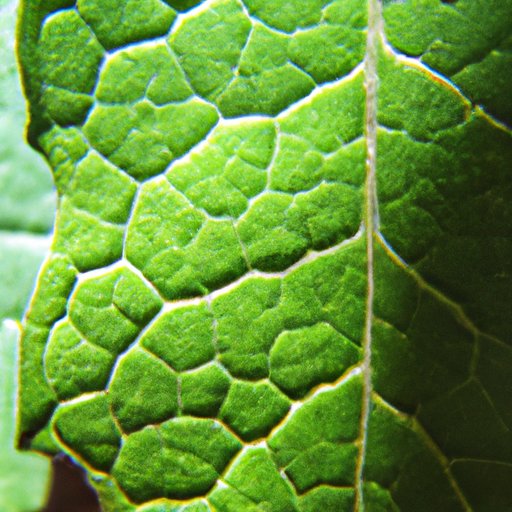Introduction
Have you ever wondered why leaves are green? You may have given it some thought, but do not know the exact answer. Although green leaves are beautiful and essential for us, there is more to it than meets the eye. Understanding why leaves are green is crucial for the survival of plants and, by extension, our environment. This article covers the science and significance behind why leaves stay green and the process behind photosynthesis.
The Science Behind Why Leaves Stay Green: An In-Depth Look
Leaves are an integral part of plants, and they come in various shapes, sizes, and colors. Leaves, among other things, are responsible for photosynthesis, which is the process that allows plants to convert carbon dioxide, water, and sunlight into oxygen and energy. They take in carbon dioxide and release oxygen during the photosynthesis process, generating over half the oxygen in the Earth’s atmosphere.
Moreover, the complex structure of leaves determines their role in the process of photosynthesis. Leaves consist of three main components: the epidermis, the mesophyll, and veins. The epidermis is the outer layer of the leaf, and it protects against water loss in the leaf. The mesophyll is the middle layer of the leaf, and it contains the cells that undergo photosynthesis. The veins transport water, minerals, and nutrients from the roots to the rest of the plant.
The process of photosynthesis begins in the chloroplasts of the mesophyll cells, where sunlight is absorbed by a pigment called chlorophyll. Chlorophyll absorbs light most efficiently in the blue and red parts of the electromagnetic spectrum. It reflects light in the green spectrum, resulting in the leaves appearing green.
The Pigments That Keep Leaves Green: Chlorophyll and Beyond
Chlorophyll is the primary pigment responsible for the green color of leaves. However, other pigments such as carotenoids and anthocyanins, contribute to the color of a leaf. Carotenoids are responsible for orange and yellow hues in leaves while anthocyanins give leaves a red or blue hue. The pigments are synthesized in the plastids of mesophyll cells, and their production is regulated by environmental factors such as light intensity and temperature.
Chlorophyll consists of two types of pigments: chlorophyll a and chlorophyll b. Chlorophyll a absorbs blue-violet and red-orange wavelengths of light. Chlorophyll b absorbs blue and red wavelengths of light. They work together to increase the absorption of light and improve photosynthesis. Chlorophyll is essential to photosynthesis because it enables plants to absorb light energy and transform it into chemical energy.
Going Green: How Leaves Use Sunlight to Stay Vibrant and Healthy
Photosynthesis is the process that leaves use to stay healthy and vibrant. However, photosynthesis requires a lot of energy, which is why leaves need a steady supply of nutrients and minerals to produce energy. Nitrogen, phosphorous, and potassium play the most significant roles in maintaining leaf health. Without them, the leaves cannot take up water and nutrients, leading to wilting and decay.
Moreover, a wide range of diseases, pests, and environmental stressors can affect the health and appearance of leaves. For example, fungal diseases can cause dark spots on the leaves, while insects such as aphids can cause puckering and deformation in leaves. Environmental stressors, such as drought or pollution, can disrupt photosynthesis and damage the leaves.
Nature’s Aesthetic: Exploring Why Green is the Dominant Color in Leaves
Green stands out as the most dominant color in leaves because it is the most efficient color when it comes to absorbing light energy from the sun. The plant kingdom has evolved to make use of the most efficient color of light for photosynthesis, and green, due to its proximity with chlorophyll in the electromagnetic spectrum, is that color. By reflecting green light, leaves maximize the absorption in other parts of the spectrum, increasing photosynthesis efficiency.
Furthermore, the green color in leaves is influenced by various factors, including temperature and light intensity. The amount of chlorophyll production changes with changes in weather and growing conditions. For instance, during the fall season, the shorter days and cooler temperatures result in decreased chlorophyll production, leading to changes in leaf color, as well as the eventual shedding of leaves.
A Closer Look at Photosynthesis: How It Keeps Leaves Green and Our Planet Thriving
Photosynthesis is a crucial process for our environment as it produces the oxygen we breathe and removes carbon dioxide from the atmosphere. By using chlorophyll to convert sunlight into energy, plants use some of the carbon dioxide produced in the atmosphere, which helps to reduce greenhouse gases that contribute to climate change.
Moreover, photosynthesis plays a vital part in the carbon cycle. During photosynthesis, plants absorb carbon dioxide from the air to produce carbohydrates for energy, and oxygen is released as a by-product. When the plant dies or is consumed by animals, the stored carbon returns to the atmosphere. The carbon cycle ensures that carbon circulates around our planet and is not lost or accumulated in one place, which helps to regulate the Earth’s climate.
Conclusion
Why leaves stay green may seem like a simple question, but understanding the complex science behind it is vital to the survival of our environment. By understanding how photosynthesis works, we can appreciate the incredible process plants carry out to produce energy and oxygen. We also learn the significance of the color green, which maximizes the energetic efficiency of photosynthesis. Finally, we recognize the essential role of leaves in the carbon cycle and maintaining the ecological balance in our environment.
For those interested in exploring plant life further, we recommend further research on the various nutrients and minerals required for optimal plant growth and development. We also encourage the use of sustainable farming practices that preserve the health of our environment and its inhabitants.
